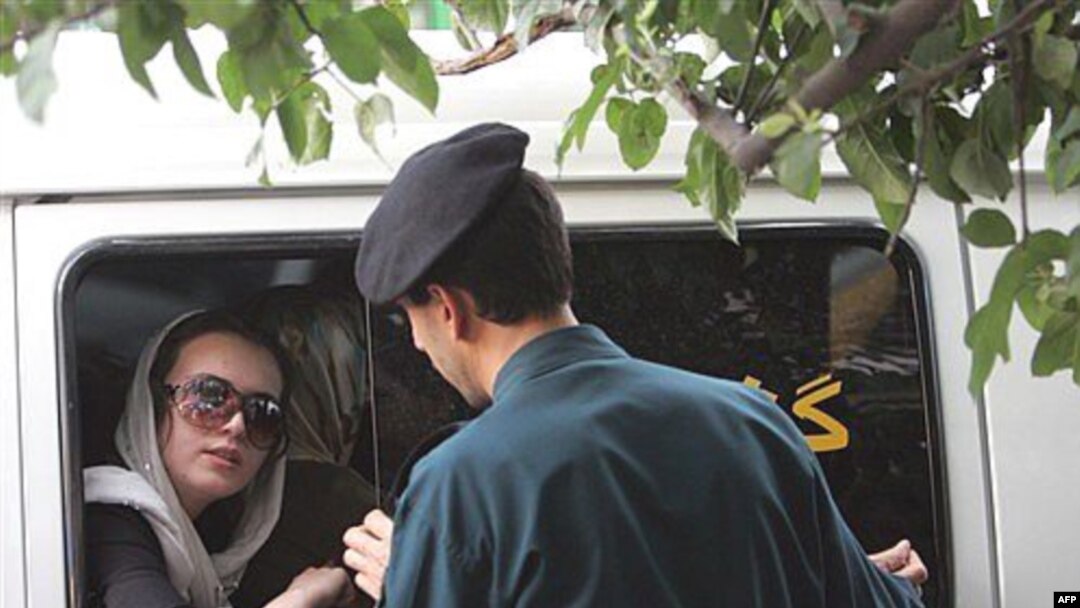"I just got a new haircut and had my eyebrows shaped," Ali M. says over the phone from Tehran, jokingly but with a hint of pride in his voice.
In recent months, Iranian authorities have cracked down hard on Iranians who violate the dress code, which requires women to wear the head scarf and prohibits men from wearing short-sleeve shirts or ties. But that hasn't stopped legions of women and men from dressing as stylishly as they can. In fact, the more the authorities try to enforce the code, the more it seems Iranians want to push the boundaries of personal fashion -- even at the risk of fines and imprisonment.
Click here for a photo gallery of Iran's Islamic fashions -- and the improper styles that have landed some Iranians in jail.
Police often detain people with “improper clothing and haircuts,” but Ali M. says he couldn't care less. And he says there are millions like him, picking up on international fashion trends from satellite television channels, glossy magazines, and foreign travel.
Ali says he and his fellow Iranian "fashionistas," many of whom dress modestly in public but turn on the style at private gatherings, want to wear the latest designer labels and hairstyles. “I usually watch Fashion TV, World Fashion and other satellite channels,” he tells RFE/RL. “My favorite brand is Dolce and Gabbana (D&G). When I buy clothes, I try to follow the D&G style. Sometimes I buy this brand. Actually, yesterday I bought a pair of shoes from D&G’s limited edition. They are silver-colored with red lines on the seams.”
Ali M. works as the Tehran representative of a well-known European company that sells skincare products and perfumes. He says he can afford to purchase goods in numerous chic boutiques and get his hair done at salons where prices start from $100 per haircut.
Their Hearts' Desires
Tehran is full of trendy boutiques and shops offering Western-style clothes, including skimpy tops and figure-hugging trousers -- even though such items are forbidden. Ali M. says many well-known firms, such as Christian Dior or Armani, have branches in Iran where they sell their comestics. However, they don’t directly sell clothes, which instead are often specially ordered through private shops.
Apparently, nothing can discourage Iranians from trying to dress fashionably -- not the restrictive laws, not the morality police, not even exorbitant prices for designer labels.
According to Ali M., those "who cannot afford to pay $600 for a pair of designer shoes, can easily find an exact replica of the designer label for $60. The same goes for dresses, tops, and coats."
In interviews, some Iranian women say they lead double lives when it comes to clothes and fashion. One Tehran woman told RFE/RL: "We get dressed modestly for work, but privately we follow our hearts' desires -- opting, for instance, for sleeveless tops, plunging necklines, and short trousers."
Iraj Jamsheedi, an Iranian independent journalist, says many Iranians, especially urbanites, are increasingly frustrated with authorities meddling in their private lives. "Many people ignore the rules as much as they can, simply to protest this and other social restrictions," Jamsheedi says.
"Official decrees have failed to change people's dress sense. In many instances, the dress restrictions have had the opposite effect -- people's clothes have become more [liberal] than before. It is a sign that people are resisting these decrees."
Undeterred Youth
Neelofar, a 23-year-old Tehran resident, says she was detained by the morality police in a shopping center last summer. She was wearing "an overly short pair of trousers and showing too much hair under a loosely tied colorful head scarf."
Speaking to RFE/RL, Neelofar says she was taken to a police station along with a couple of other dress-code offenders. The police officers called Neelofar's parents who brought a "proper overcoat" for their daughter and gave a written pledge that Neelofar would never violate the law again.
Neelofar, however, had different ideas. "I didn't obey [the dress code] too much after the incident," she says. "But I wasn't detained anymore, maybe because I don't walk in the streets too much -- I usually travel by car or bus. Usually, [detention] happens to people who walk in the streets."
Jamsheedi regards the drive to enforce the dress code as part of a larger effort to control society. "The situation in Iran is not simple," the Tehran-based journalist says. "A social uprising could break out any minute. The authorities want to prevent any such upheaval by tightening their grip on people's lives."
Nuisha Boghrati and Farin Assemi from Radio Farda contributed to this report


